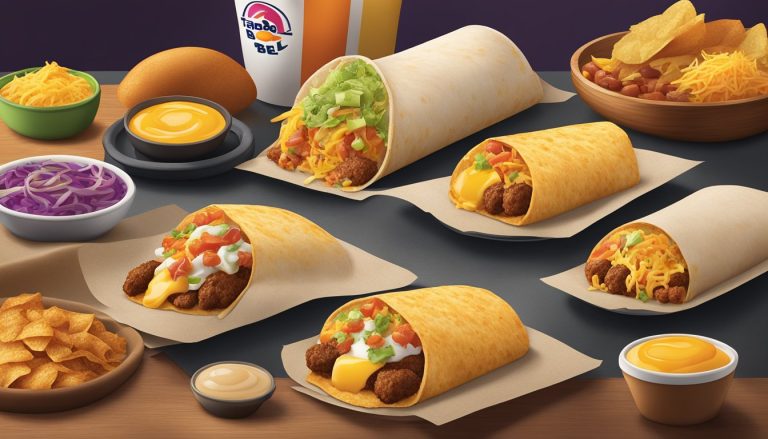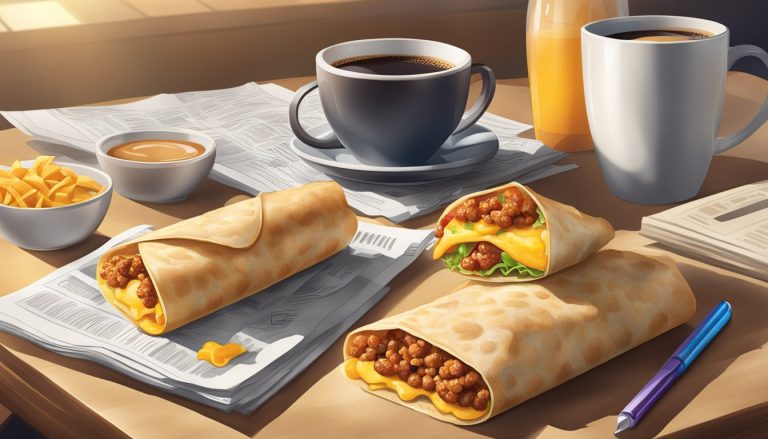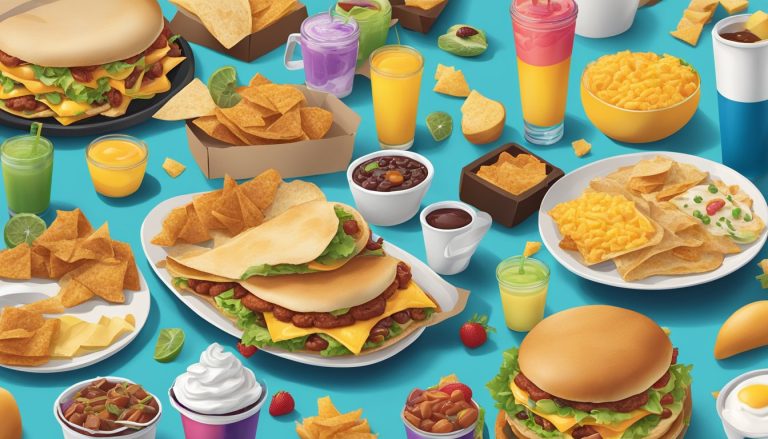Taco Bell’s foray into breakfast in 2014 marked a significant shift in the fast food landscape. The introduction of innovative items like the Waffle Taco and A.M. Crunchwrap not only expanded the chain’s menu but also tapped into a new market segment. Taco Bell’s breakfast offerings quickly became a cultural phenomenon, sparking conversations and trends across social media platforms.
The brand’s approach to breakfast aligned seamlessly with its overall marketing strategy, which has long capitalized on pop culture moments and maintained a strong social media presence. Taco Bell’s ability to create buzz around its breakfast menu items demonstrated the power of its marketing savvy and cultural relevance.
While Taco Bell’s breakfast menu faced challenges, including a temporary discontinuation in 2020, its impact on pop culture and media remained significant. The brand’s breakfast offerings became a topic of discussion on platforms like TikTok, further solidifying Taco Bell’s position as a trendsetter in the fast food industry.
Evolution of Taco Bell’s Breakfast Menu

Taco Bell’s breakfast menu has undergone significant changes since its nationwide launch in 2014. The chain has consistently pushed boundaries with unique offerings that blend Mexican-inspired flavors with traditional breakfast fare.
Menu Innovation
Taco Bell’s breakfast menu debuted on March 27, 2014, marking a bold entry into the competitive morning food market. The initial lineup featured innovative items like the Waffle Taco, which combined sweet and savory elements. This launch was supported by Taco Bell’s largest marketing campaign to date.
As consumer preferences evolved, so did the menu. Taco Bell adapted by introducing new items and phasing out underperforming ones. The chain focused on portability and customization, catering to on-the-go consumers.
Product Innovation
Taco Bell’s approach to breakfast product innovation centers on creating unique flavor combinations. The chain has leveraged its expertise in Mexican-inspired cuisine to develop breakfast items that stand out from traditional offerings.
One notable innovation is the breakfast Crunchwrap, a portable meal combining eggs, cheese, and meat in a grilled tortilla. This product exemplifies Taco Bell’s strategy of reimagining familiar breakfast components in a novel format.
Innovative Menu Items
Taco Bell’s breakfast menu has featured several standout items that have captured public attention. The Cinnabon Delights, small fried dough balls filled with cream and coated in cinnamon sugar, quickly became a fan favorite.
Another popular addition was the breakfast version of the iconic Doritos Locos Tacos. This item showcased Taco Bell’s ability to adapt its signature products for the morning daypart.
The chain has also experimented with unexpected breakfast offerings, such as the Mexican Pizza breakfast variant, further demonstrating its commitment to food innovation in the breakfast space.
Marketing Strategies for Breakfast Offerings
Taco Bell’s breakfast marketing strategies have been innovative and targeted. The fast-food chain has employed a mix of digital tactics, celebrity partnerships, and engaging campaigns to capture the attention of young consumers.
Target Audience Engagement
Taco Bell’s breakfast marketing focuses primarily on millennials and Gen Z. These younger demographics are more likely to seek out non-traditional breakfast options. The company tailors its messaging and product offerings to appeal to their tastes and lifestyle.
Social media plays a crucial role in reaching this audience. Taco Bell uses platforms like Instagram and TikTok to showcase its breakfast menu items in creative ways. User-generated content is encouraged, with hashtag campaigns prompting customers to share their Taco Bell breakfast experiences.
The brand also emphasizes convenience and affordability in its messaging. Mobile ordering and delivery options are highlighted to cater to the on-the-go lifestyles of young adults.
Advertising Campaigns
Taco Bell’s breakfast advertising campaigns are known for their bold and often humorous approach. The company has invested in high-profile TV spots, including Super Bowl commercials, to generate buzz around its breakfast offerings.
One notable campaign featured the “Breakfast Defectors” concept, encouraging consumers to break away from traditional breakfast choices. This campaign used a mix of TV ads, online videos, and social media content to spread its message.
Celebrity partnerships have been a key component of Taco Bell’s breakfast marketing. Collaborations with stars like Doja Cat and LeBron James have helped increase brand visibility and appeal to younger consumers.
Digital Marketing Tactics
Taco Bell leverages various digital marketing tactics to promote its breakfast menu. The company’s mobile app plays a central role, offering exclusive deals and easy ordering options for breakfast items.
Email marketing campaigns target registered users with breakfast promotions and new menu item announcements. Push notifications remind app users about breakfast hours and special offers.
The brand also uses geo-targeted ads to reach consumers near Taco Bell locations during breakfast hours. These ads often feature limited-time offers to drive immediate action.
Co-Branding and Partnerships
Taco Bell has pursued strategic partnerships to enhance its breakfast offerings and marketing reach. Collaborations with popular brands like Cinnabon have resulted in unique menu items that generate buzz and attract customers.
The company has also partnered with delivery services to expand breakfast availability. These partnerships are promoted through joint marketing efforts, increasing visibility across multiple platforms.
Cross-promotions with entertainment properties, such as movie tie-ins, have been used to create limited-time breakfast specials. These collaborations often include themed packaging and social media campaigns to engage fans of both brands.
Social Media’s Role in Taco Bell’s Breakfast Popularity
Taco Bell‘s breakfast menu gained significant traction through strategic social media campaigns. These efforts leveraged user-generated content and celebrity endorsements to boost brand awareness and engagement.
User-Generated Content and Engagement
Taco Bell encouraged customers to share photos and reviews of their breakfast experiences on platforms like Instagram and Twitter. The company created hashtags like #WakeUpLiveMas to track and amplify these posts. This approach increased visibility and fostered a sense of community among Taco Bell enthusiasts.
The brand also hosted social media contests, prompting users to create content featuring Taco Bell breakfast items. These initiatives drove organic reach and sparked conversations about the menu offerings.
Taco Bell’s social media team actively responded to customer comments and inquiries, maintaining a two-way dialogue. This responsiveness helped build customer loyalty and reinforced the brand’s reputation for attentive service.
Celebrity Endorsements and Influencers
Taco Bell partnered with celebrities and social media influencers to promote its breakfast menu. These collaborations ranged from sponsored posts to more elaborate marketing stunts.
Notable figures in pop culture shared their Taco Bell breakfast experiences, lending credibility and cool factor to the menu. The brand carefully selected influencers whose audiences aligned with Taco Bell’s target demographic.
Some campaigns featured unexpected pairings, such as partnering with fitness influencers to highlight healthier breakfast options. This strategy helped broaden Taco Bell’s appeal and challenge preconceptions about fast food breakfast.
Impact on Pop Culture and Media Representation

Taco Bell’s breakfast offerings have significantly shaped pop culture and media portrayals. The brand’s innovative approach to morning meals has sparked conversations, memes, and cultural trends.
Taco Bell’s Cultural Influence
Taco Bell’s breakfast menu has become a cultural touchstone. The “Live Más” slogan extends to morning hours, encouraging consumers to embrace bold flavors early in the day. This approach positions Taco Bell as a cultural rebel, challenging traditional breakfast norms.
The concept of “Taco Tuesday” has expanded to include breakfast items, creating a new social media trend. Fans share photos of their morning Crunchwraps, driving engagement and visibility for the brand.
Taco Bell’s breakfast menu has inspired countless memes and viral content. This user-generated material amplifies the brand’s reach and relevance in digital spaces.
Humor and Brand Personality
Taco Bell’s breakfast marketing leverages humor to connect with audiences. Witty advertisements and social media posts showcase the brand’s playful personality, making it relatable to younger consumers.
The company’s self-aware approach to breakfast advertising often pokes fun at traditional morning meal conventions. This strategy resonates with audiences who appreciate brands that don’t take themselves too seriously.
Taco Bell’s storytelling around breakfast items often features unexpected scenarios and quirky characters. These narrative elements create memorable campaigns that stick in consumers’ minds.
The brand’s humorous take on breakfast has inspired comedy skits, late-night TV jokes, and social media parodies. This broader cultural impact reinforces Taco Bell’s position as a pop culture fixture.
Brand Loyalty and Customer Relationship Management

Taco Bell has implemented strategic initiatives to foster brand loyalty and strengthen customer relationships. These efforts encompass loyalty programs, customer feedback mechanisms, and community-oriented initiatives that demonstrate social responsibility.
Loyalty Programs and Customer Feedback
Taco Bell’s loyalty program, Taco Bell Rewards, offers customers points for purchases redeemable for free menu items. Members receive exclusive offers and early access to new products, incentivizing repeat visits. The program integrates with the Taco Bell mobile app, streamlining the ordering process and enhancing customer convenience.
Customer feedback plays a crucial role in Taco Bell’s strategy. The company actively solicits input through surveys, social media, and in-app feedback options. This data informs menu innovations and service improvements, ensuring the brand remains responsive to customer preferences.
Taco Bell’s emphasis on digital engagement has led to a 17% increase in active users of its loyalty program in 2023. This growth reflects the success of their customer-centric approach and digital integration efforts.
Community Initiatives and Social Responsibility
Taco Bell demonstrates social responsibility through various community initiatives. The Live Más Scholarship supports young innovators and creators, awarding millions in educational funding. This program aligns with Taco Bell’s brand values and cultivates goodwill among younger demographics.
The Feed the Beat program showcases Taco Bell’s commitment to music and culture. It provides support to emerging artists, strengthening the brand’s connection with its target audience. This initiative creates positive associations and reinforces Taco Bell’s image as a culturally relevant brand.
Taco Bell’s community engagement extends to local franchises, which often participate in fundraisers and sponsorships. These efforts build strong ties with local communities and enhance brand perception at a grassroots level.
Taco Bell’s Market Position and Competitive Landscape

Taco Bell maintains a strong position in the fast-food industry, driven by innovative marketing and menu offerings. The chain faces competition from other quick-service restaurants while continuing to expand its market share and sales growth.
Sales Growth and Fast-Food Industry Trends
Taco Bell has experienced steady sales growth in recent years. In 2024, the chain reported system-wide sales of $12.6 billion, a 5% increase from the previous year. This growth outpaced the overall fast-food industry average of 3.2%.
The company’s success can be attributed to several factors:
- Menu innovation, including popular breakfast items
- Effective social media marketing campaigns
- Expansion into new markets and locations
Taco Bell has also capitalized on industry trends such as:
- Increased demand for plant-based options
- Growing popularity of mobile ordering and delivery services
- Focus on value-driven menu items
Competing with Quick-Service Restaurants
Taco Bell faces strong competition from other fast-food chains and quick-service restaurants. Key competitors include:
- Chipotle Mexican Grill
- Del Taco
- Wendy’s
To maintain its competitive edge, Taco Bell has implemented several strategies:
- Emphasizing unique menu items not found at other chains
- Offering competitive pricing and combo deals
- Investing in restaurant redesigns and technology upgrades
Taco Bell’s market share in the quick-service Mexican food segment stands at 62%, showcasing its dominance in this niche. The chain continues to differentiate itself through bold marketing campaigns and product innovation, helping it stand out in the crowded fast-food landscape.
Business and Marketing Leadership
Taco Bell’s success in the breakfast market stems from innovative leadership and strategic marketing approaches. The company’s executive team and marketing department have played crucial roles in shaping brand perception and driving growth.
Roles and Contributions of Taco Bell’s CMO
CMO Taylor Montgomery has been instrumental in steering Taco Bell’s marketing efforts. Montgomery’s leadership has focused on leveraging digital platforms and social media to connect with younger consumers.
Under Montgomery’s guidance, Taco Bell has embraced bold, attention-grabbing campaigns. The marketing team has prioritized creating shareable content and fostering online engagement to amplify brand messaging.
Montgomery has also championed data-driven decision-making, using consumer insights to refine menu offerings and promotional strategies. This approach has helped Taco Bell stay relevant in a competitive fast-food landscape.
Evolving Marketing Mix and Strategies
Taco Bell’s marketing mix has evolved to emphasize digital channels while maintaining traditional media presence. The brand has invested heavily in mobile apps, online ordering systems, and loyalty programs to enhance customer experience.
Social media plays a central role in Taco Bell’s marketing strategy. The company uses platforms like Instagram and Twitter to showcase new menu items and engage directly with customers.
Taco Bell has embraced influencer partnerships and user-generated content to boost brand recognition. These tactics have proven effective in reaching younger demographics and driving viral marketing campaigns.
The brand continues to experiment with innovative marketing tactics, including augmented reality experiences and limited-time promotions. These efforts aim to create buzz and maintain Taco Bell’s position as a culturally relevant fast-food option.
Adopting to Local Preferences and Global Expansion

Taco Bell’s expansion beyond the United States has required adapting its menu and marketing to suit diverse cultural tastes. This strategy has enabled the chain to establish a strong presence in international markets while maintaining its core brand identity.
Localization of Menu and Marketing
Taco Bell tailors its offerings to match local palates in different countries. In India, the menu features more vegetarian options and spicier flavors to cater to regional preferences. The UK locations offer beer and unique items like the Chicken Fajita Burrito. Japan’s Taco Bell restaurants serve exclusive dishes like the Shrimp & Avocado Burrito.
Marketing campaigns are also customized for each market. In Mexico, Taco Bell positions itself as a unique American-style Mexican food experience. The brand uses social media influencers and local celebrities to connect with younger audiences, particularly college students, in various countries.
Global Growth and Cultural Adaptation
Taco Bell’s global expansion strategy focuses on understanding and respecting local cultures. The company conducts extensive market research to identify consumer preferences and dining habits in each new market. This approach has led to successful entries in over 30 countries.
In Spain, Taco Bell introduced a tapas-style menu to align with local eating customs. The chain’s restaurants in China feature open kitchens to address food safety concerns. Taco Bell also adapts its restaurant designs to suit local architectural styles and urban planning requirements.
By blending its signature Tex-Mex flavors with local ingredients and culinary traditions, Taco Bell has created a unique position in the global fast-food landscape. This strategy has helped the brand attract both curious locals and expats seeking familiar tastes.
Product Accessibility and Value Proposition

Taco Bell’s breakfast offerings emphasize affordability and convenience. The chain leverages its existing strengths in value pricing and digital ordering to make its morning menu widely accessible.
Pricing Strategy and Value Menu
Taco Bell applies its signature value-driven approach to breakfast. The menu features items priced as low as $1, allowing customers to build satisfying meals without breaking the bank. Popular options like the Breakfast Crunchwrap and Cheesy Toasted Breakfast Burrito are often included in value bundles.
The chain regularly introduces limited-time breakfast deals to drive traffic. These promotions, such as $5 breakfast boxes, combine multiple menu items at a discount. Taco Bell’s competitive pricing aims to attract budget-conscious consumers and compete with established breakfast players.
Mobile App and Ordering System
Taco Bell’s mobile app streamlines the breakfast ordering process. Users can customize menu items, save favorites, and reorder previous meals with a few taps. The app offers exclusive breakfast deals and rewards, incentivizing digital engagement.
The chain’s drive-thru lanes prioritize mobile orders, reducing wait times for app users. This system proves especially valuable during the morning rush. Taco Bell has also implemented dedicated mobile pickup areas in many locations, further expediting service.
These digital tools enhance accessibility, allowing customers to quickly grab breakfast on-the-go. The convenience factor plays a crucial role in Taco Bell’s efforts to capture market share in the competitive fast food breakfast segment.
Historical Significance and Iconic Moments

Taco Bell’s journey into breakfast has been marked by bold marketing moves and innovative menu items. These efforts have cemented the brand’s place in pop culture and fast food history.
Memorable Campaigns and the Chihuahua
Taco Bell’s marketing campaigns have left an indelible mark on pop culture. The Chihuahua mascot, introduced in 1997, became an instant sensation. The dog’s catchphrase “Yo quiero Taco Bell” was repeated across the nation.
This campaign ran until 2000 and sparked merchandise lines and even lawsuits. It remains one of the most recognized fast food advertising campaigns in history.
Taco Bell’s breakfast launch in 2014 was accompanied by clever marketing. They poked fun at McDonald’s with ads featuring real people named Ronald McDonald enjoying Taco Bell breakfast.
Nacho Fries and Signature Innovations
Taco Bell’s menu innovations have consistently grabbed headlines and social media attention. The introduction of Nacho Fries in 2018 was met with overwhelming enthusiasm.
This limited-time offering became Taco Bell’s most successful product launch ever. It sparked numerous television commercials, including mock movie trailers starring Josh Duhamel.
Other signature items like the Doritos Locos Tacos and the Quesalupa have also made waves. These products blend familiar flavors with unexpected formats, driving buzz and sales.
Taco Bell’s breakfast menu continues this tradition of innovation. Items like the Breakfast Crunchwrap and Cinnabon Delights offer unique alternatives to traditional morning fare.




